There's been some discussions recently on methanol kits, PPS vs PWM. Here's an article/study done and posted on NASIOC that discusses systems and their operation for those interested in reading it and learning.
Its a mouthful for most but if you enjoy getting into the nitty-gritty and have time to read, grab a coffee or beer some snacks and dive in.
To tell you the truth I haven't had the time to read all of it just yet either but thought it might be worth sharing out there to possibly help clarify questions for others asking similar questions down the road. Some of the things mentioned won't apply entirely to the N54 (namely AFR tuning isn't as wacky to tune on this platform due to being fully closed loop) but others are good to see such as videos of effects on atomization with varying pump speed and reasons why PPS kits are in most cases made into on/off kits. In addition to that, the PPS kits typically used on the N54 run the Aquatec 220psi capable pumps which also skew some info presented here as the pump can deliver higher than 150psi pressures. It was written by Aquamist and I'm sure the possibility of marketing spiel is there as well but there's enough quality in the study to describe the differences in the PPS vs PWM for those interested in learning...
Article/study was last updated Feb 16, 2012 so fairly recent.
======
It is my attempt of explaining how different type of systems work and its advantage and dis-advantage, based on current systems offered. It is a my view and findings, please do chime in and discuss.
1) Single-stage
2) Two-stage
3) Progressive Pump Speed system (PPS)
4) PWM Valve controlled system
5) System that will integrate well with third party controllers.
6) Direct port
------------------------------------------------------------------------
The single stage:
The single stage WAI (water alcohol injection), as the heading implies, is not as basic as most people expects. It some cases, it will out perform a two-dimension progressive system. Please do not underestimate it. I will try to explain briefly why after the next few paragraphs.
Having a single trigger point and a fixed flow rate, one will get to know its effect on your engine very quickly. Due to its consistent repeatability, it is very easy to tune. This type of system is normally set to start spray in the peak torque region, where the engine is most likely to knock.
As the RPM climbs, the ratio of water to mass air tends to decrease. This may not be a bad thing because the tendency to knock is also lessen as the wastegate starts to open and prevent the boost pressure from increasing further. The volumetric efficiency of the engine also decreases as RPM climbs, breathing in less air. This also has the effect of reducing the engine's tendency to knock, demand of WAI flow is less. Unfortunately some engines do require continuous WAI flow at higher RPM due to heat build up through friction and turbo efficiency.
A 2-D pump speed system based on manifold pressure is a little bit tricky to tune compared to the single stage system. The user has to set the start and finish pressure points, those points are sometimes set at a considerable distance apart. Matching those operation points in a 3-D environment such as RPM/Boost ramp (nonlinear) is quite difficult. We will be discussing it in more details later.
FOR:
1) Low cost, simple and dependable.
2) Easy to tune
3) Very effective on a stock factory set up with a few pounds of boost extra.
AGAINST:
1) Dynamic operating range is narrow, may not be as effective on a high RPM knock suppression.
2) For high power/ high % alcohol applications, considerable fuel has to be taken out (boost clamp) to make the afr tolerable. Some sort of failsafe mechanism is necessary to prevent engine destruction when the WAI fails to delivery the correct flow.
At present, adding a second manifold pressure switch to active an additional solenoid valve at a higher manifold pressure is the definition of a 2-stage system.
This arrangement gives the system greater flexibility as well as extending the flow range. It addresses the problem associated with the single stage system, too much flow at the start and not enough when RPM climbs beyond the wastegate setting.
As the system is based on boost trigger, it still won?t address the RPM related flow. For a turbo charge engine, the most significant active regions are the boost ramping stage and engine?s maximum torque range. A two-stage system fits these two regions nicely, allowing the some form of cooling demand during the ramp-up stage. The second stage provides the in-cylinder cooling and knock suppression as the engine is under the most stress or highest BMEP (Brake Mean Effective Pressure).
FOR:
1) Relatively low cost to give mark improvement to the single-stage system.
2) Provides well defined triggering points during the boost cycle.
3) Minimising the under/over flow problem.
AGAINST:
1) Trigger points requires some time to set up.
2) Triggering points may differ on each gear if you have a fast spool up turbo
3) Require a bit more care during tuning
![Click here to enlarge]()
Does the pump speed controller perform better than a two-stage system, you are about to find out.
Changing pump speed merely put more pressure behind a nozzle, hence more flow. This type of system is commonly known as a progressive system (pump-speed).
Let us examine how much a M5 nozzle will flow between 40psi to 160psi. According the chart below (Published by Hago, a well know US oil heater nozzle manufacturer), the flow starts from 200cc/min and ends at 400cc/min., when pressure is increased from 40psi to 160 psi.
![Click here to enlarge]()
Almost all PWM pump controller on the market uses Shurflo pump, designed to operate between 0-150psi. The heart of the system is an electronic motor speedcontroller, vary the speed according to a sensor. It could be a MAP sensor, a MAF or any sensors that read engine load. It is normally a 2-dimensional system. A manifold-pressure type system does not take into account of any RPM change.
A swirling type atomising nozzle requires a head pressure of at least 30psi to produce a decent mist. Droplet size is very important to the inlet cooling ability and even cylinder distribution. Let say the system pressure starts at 40psi (as shown on the chart) and ends at 160psi. One can assume you will get a 4x flowrange? In practice, not so, according to the chart, you will only get a flow change from 200cc/min to 400cc.min (see M5) instead of 200cc/min to 800cc/min. Flow/pressure obeys the square-root law.
![Click here to enlarge]()
Being "progressive" implies a reasonable dynamic range between start and finish. How progressive? Almost no one ever questions this. Most people just assumes it covers all the flow requirement between 10psi to 20 psi of boost once the range-dials are set on their pump speed controller. In practice, you cannot expect the same M5 nozzle will serve a wider operating range between 5-25psi by merely changing the dial, the range is governed by the law of physics and not a technically advanced motor speed controller.
If one would want to delve deeper into the subject, as the title demands. So the subject will continue?
Just to recap, good dynamic range (pressure/flow span) is the main factor one should expect from a "progressive" WIA system. Let see what a 150psi system can really offer. We shall take into account of the effect of manifold pressure, inline checkvalve as well as minimum pressure for a good atomised spray.
For example:
1) Manifold pressure start: 10psi
2) Manifold pressure ends: 20psi
3) Inline checkvalve crack pressure: 20psi (updated)
4) Minimum pressure of the atomising nozzle:40psi (Hago chart).
When the system starts: it will instantly see an initial back-pressure of 60psi and a final back-pressure of 70psi (extra manifold pressure). The actual dynamic pressure range is now from 60psi to 110psi. The system can now only manage a 35% change in flow, far from one would imagine a 150psi pump system should perform.
![Click here to enlarge]()
There are other factors that could also affect the performance of the 2-D progressive pump system. It may be a subject for a later discussion, depending on the interest of the readers. Chart below is a predicted performance of a progressive system compared to a single and two-stage system. I hope there will be people chiming in to add to this. At first glance, it doesn't appear there is a distinct advantage for adding a progressive controller. Adding a bigger nozzle doesn't alter the dynamic range, it just shifts the whole curve higher.
![Click here to enlarge]()
FOR:
1) Easy to set the start and end point.
2) Some correlation between manifold pressure and flow
3) Cost effective.
AGAINST:
1) Limited dynamic range, system becomes less effective after wastegate pressure. (see addendum)
2) Extra cost can easily be spent on a higher performance two-stage system with greater dynamic range .
3) If the 2-D system is used to replace high % fuel with alcohol, re-mapping the 3-D fuel map will be very difficult due to the wide dynamic flow rangedemanded by the engine.
4) Pulsing due to demand switch ~20psi ripple. (some system by-pass this switch, but risking system pressure beyond design limits). May require further explaination
5) Response time due to inertia of a rotating - laggy (start) and over-run (stop). May require further explaination
PWM valve water injection system:
These systems require a stable system pressure, normally held between 100-125psi. An inline solenoid valve and a PWM controller that modulates the opening and shutting time to meter flow. Before getting too deeply into the subject, note that there are two types of inline solenoid valves on offer.
Type #1
Pulse width modulation type:
(Optimum operating frequency range: 30-80Hz)
![Click here to enlarge]()
This type of system resembles the modern automotive![Click here to enlarge]() fuel injection system. The system can also be controlled by a third party EMS with a spare PWM channel. Delivery rate can either be mapped or mirroring the fuel injector duty cycle. The latter makes tuning very simple.
fuel injection system. The system can also be controlled by a third party EMS with a spare PWM channel. Delivery rate can either be mapped or mirroring the fuel injector duty cycle. The latter makes tuning very simple.
The valve behaves similar to an on/off gated button on a garden hose. The longer the gate is opened, the more the flow (duration). Alternative, rapid opening/shutting the gate per second (frequency) also control the flow. The common EMS uses duration for load change and frequency for RPM change. The dynamic flow range is extremely wide, 100:1 is normal.
A WAI valve should closely match the closing and shutting characteristic of a fuel![Click here to enlarge]() injector. This is important for fuel flow mirroring algorithm since the modern EMS has a correction stage to compensate the opening delay and shutting delay.
injector. This is important for fuel flow mirroring algorithm since the modern EMS has a correction stage to compensate the opening delay and shutting delay.
![Click here to enlarge]()
-------------------------------------
Type #2
Proportional lift type:
(Chopped DC (~400Hz) or DC current)
![Click here to enlarge]()
This type of valve resembles the action of a rotary water tap. As more current is applied to the valve coil, the higher the valve lifts from the seat. It is a very nice way to control flow.
There are a few minor problems associated with this type of valve: Atomisation at low flow (see paragraph below) and lift variations (hystersis of the magnetic circuit), approximate +/- 10-15% flow deviations.
All in all, it will deliver liquid well compared to the PPS system. There are some similarities between the two. The nozzle tip pressure is directly proportional to the flow. This is because the proportional valve acts like a variable restrictor upstream of the nozzle tip. Resulting in: restricted flow = low pressure. Low pressure = low atomisation.
![Click here to enlarge]()
----------------------------------
Summary:
It is important to know some basic facts between the two PWM valve systems before choosing this type of system.
Here is an illustration of the difference in construction of the two valves, made by Clippard. Notice the "PWM" (full "on/off) has a softer spring rate than the "proportional lift" valve, enabling the PWM valve to perform "full on" and "full off" positively.
![Click here to enlarge]()
Because the way the PWM system meters its flow based on a simple pulse width, it is very accurate. Further precision can be increased by introduce a suitable RRFPR to maintain Manifold pressure against manifold pressure. It is also possible to factor in a small duty cycle increase to the valve relative to boost increase.
Final consideration: If you are planning in future to create your own MAP via a third part system - only the "PWM-valve" can be driven directly by the ECU, matching the principle of a modern "fuel injection system" in every respect. Warning, before rushing off making your own system, Clippard valve is only rated up to 100psi, even with the smallest orifice version. The larger orifice type can only sustain 25psi. Multivalve is needed for flows over 500cc/min. Lastly, the valve mentioned has a typical 4mS on and 4mS off time.
END
---------------------------------------------------------------------------
Almost all progressive systems use a checkvalve between the pump output and nozzle for the reasons listed below:
Positive effects (well documented):
1. Retain some pressure in the line to compensate the next injection event. A 20psi loaded checkvalve will keep 20 psi of pressure in the line after injection.
2. Stop water being siphoned into the engine if the water jet is installed in the vacuum side of the manifold.
3. Prevent emptying the entire tank into the inlet tract if the tank location is higher than the jet (gravity fed) or the car is parked on an incline.
4. Stop some dribble after an injection event. Even when the power of the pump is switch off, the inertia of the rotating mass keeps the pump running for a second or so.
Negative effects (less well documented):
5. The presence of a checkvalve has a very significant impact of the dynamic range of a 150psi progressive pump speed system. A 20 psi checkvalve inline will instantly drop the 150 PPS system down to a 130psi span.
6. A normal nozzle requires ~30psi for produce a decent atomised spray. An inline 20psi checkvalve means the pump has to produce 50psi to produce a decent spray.
7. Let say the PPS system’s starting point is at 12psi boost, the system will now require 62psi to produce a decent spray. Some vendor will tell you a check valve will not impede flow once it is opened, true. But it will tax the pressure heavily where the PPS system relies heavily upon.
8. When the PPS system arrives at 24psi boost (end point) manifold pressure, the dynamic pressure is now further taxed. Before not too long later the dynamic range of a PPS system is now from 62psi to 126psi – translate it to flow: 176cc/min to 326cc/min, a mere 84% percent increase.
9. I have taken some data from a reputable PPS system manufacturer, a 150-psi 60W Shurflo flow pump has the follow characteristics:
Most important thing to remember, nozzle size determines output pressure (updated on the 21st January 2008) .
M1 (not tested)
M2 230psi
M3 225psi
M3 215psi
M5 190psi
M7 180psi
M10 170psi
M12 (not tested) did not have one handy.
M14 155PSI
From the figures above, the pump is only capable of sustaining 135psi system pressure on a M5 nozzle. Despite claiming the pump is capable of flowing one 3-4 litre per minute, conveniently missing the pressure parameter. The above PPS system maker is the only one that published these figures in public – thumbs up for them.
NOTE: The above data is from one maker only (as stated) Please read post #3 to understand why different WAI makes uses differ pumps, some make more flow and pressure than others.
Summary:
Some PPS system makers are now offering an inline solenoid upgrade so that the dynamic range is improved by a good margin. Not sure why they didn’t include it in the kit at the beginning. Many PPS systems run their pumps up to 200-300psi - something I have questioned Shurflo, they said NO, NO and NO - no "ifs" or "buts". They are looking into a higher pressure pump but not yet done and will not be released until they are comfortable with it. I have a meeting with the Shurflo's director of engineering at our works two months ago during his UK visit - he confirmed the imaginary 200psi+ pump (8000 series).
Its a mouthful for most but if you enjoy getting into the nitty-gritty and have time to read, grab a coffee or beer some snacks and dive in.
To tell you the truth I haven't had the time to read all of it just yet either but thought it might be worth sharing out there to possibly help clarify questions for others asking similar questions down the road. Some of the things mentioned won't apply entirely to the N54 (namely AFR tuning isn't as wacky to tune on this platform due to being fully closed loop) but others are good to see such as videos of effects on atomization with varying pump speed and reasons why PPS kits are in most cases made into on/off kits. In addition to that, the PPS kits typically used on the N54 run the Aquatec 220psi capable pumps which also skew some info presented here as the pump can deliver higher than 150psi pressures. It was written by Aquamist and I'm sure the possibility of marketing spiel is there as well but there's enough quality in the study to describe the differences in the PPS vs PWM for those interested in learning...
Article/study was last updated Feb 16, 2012 so fairly recent.
======
The differences between a
PWM -V system (same as OE fuel injection system)
and
PPS system (Progressive Pump Speed).
Who manufactures what?
- Devilsown, Snow, Coolingmist, AEM and (Labonte-MIA) make PPS systems.
- Aquamist and (FJO-MIA) are the only manufacturer making the PWM-V system.
Delivery method:
- PPS system: controls flow by changing pump speed.
- PWM-V system: controls flow by pulsing an inline valve (same principle as the OE fuel injection system)
Atomisation:
- PPS system: low flow = low pressure = poor atomisation
- PWM-V system: constant pressure at any flow = constant good atomisation
Consequences:
Poor atomisation results in large droplets resulting in uneven fluid entering each cylinder.
Modern manifolds are not designed for transporting fluid loaded air.
Response time:
- PPS system: slow response due to rotational inertia of the pump. typically between 0.1 to 0.5 second.
- PWM-V system: Fast response time. typically within 0.003 second.
Consequences:
In consistency in Air-fuel ratio under transient load due to the pump's inability to change speed.
- A rotating mass has ample inertia resulting in after-spray
- Fast response (random PWM) of an inline PWM valve is demonstrated. .
Dynamic range:
- PPS system: only produce 2x between 50-200 psi. (A typical PPS system operating pressure range)
- PWM-V system: comfortably manages x10 minimum flow range between 0-100% duty cycle
Consequences:
Without the dynamic range, PPS system can only operate in a narrow power range of 2x. Not really ideal for Daily Driver.
Linearity:
- PPS system: A linear "pressure" increase does not produce a linear "flow" through an atomisation nozzle. Error can be as much as 120%+.
- PWM-V system: Flow linearity is in the region of 5%, can be improved by a custom designed valve on request.
Consequences:
Wacky AFR under different load and engine speed is common - nightmare to tune.
Cost considerations:
- PPS system: It is basically a motor speed controller, design cost is low. Regardless of how many gizmos are included.
- PWM-V system: Each PWM valve individually calibrated by technicians to ensure flow consistency. Cost is high.
Consequences:
PWM-V system production cost is high. PPS systems are normally 30% lower to produce. But overall performance is 5x poorer.
PWM -V system (same as OE fuel injection system)
and
PPS system (Progressive Pump Speed).
Who manufactures what?
- Devilsown, Snow, Coolingmist, AEM and (Labonte-MIA) make PPS systems.
- Aquamist and (FJO-MIA) are the only manufacturer making the PWM-V system.
Delivery method:
- PPS system: controls flow by changing pump speed.
- PWM-V system: controls flow by pulsing an inline valve (same principle as the OE fuel injection system)
Atomisation:
- PPS system: low flow = low pressure = poor atomisation
- PWM-V system: constant pressure at any flow = constant good atomisation
Consequences:
Poor atomisation results in large droplets resulting in uneven fluid entering each cylinder.
Modern manifolds are not designed for transporting fluid loaded air.
Response time:
- PPS system: slow response due to rotational inertia of the pump. typically between 0.1 to 0.5 second.
- PWM-V system: Fast response time. typically within 0.003 second.
Consequences:
In consistency in Air-fuel ratio under transient load due to the pump's inability to change speed.
- A rotating mass has ample inertia resulting in after-spray
- Fast response (random PWM) of an inline PWM valve is demonstrated. .
Dynamic range:
- PPS system: only produce 2x between 50-200 psi. (A typical PPS system operating pressure range)
- PWM-V system: comfortably manages x10 minimum flow range between 0-100% duty cycle
Consequences:
Without the dynamic range, PPS system can only operate in a narrow power range of 2x. Not really ideal for Daily Driver.
Linearity:
- PPS system: A linear "pressure" increase does not produce a linear "flow" through an atomisation nozzle. Error can be as much as 120%+.
- PWM-V system: Flow linearity is in the region of 5%, can be improved by a custom designed valve on request.
Consequences:
Wacky AFR under different load and engine speed is common - nightmare to tune.
Cost considerations:
- PPS system: It is basically a motor speed controller, design cost is low. Regardless of how many gizmos are included.
- PWM-V system: Each PWM valve individually calibrated by technicians to ensure flow consistency. Cost is high.
Consequences:
PWM-V system production cost is high. PPS systems are normally 30% lower to produce. But overall performance is 5x poorer.
I will be posting in links and videos to support the above statements - may not be immediate but it will be done.
It is my attempt of explaining how different type of systems work and its advantage and dis-advantage, based on current systems offered. It is a my view and findings, please do chime in and discuss.
1) Single-stage
2) Two-stage
3) Progressive Pump Speed system (PPS)
4) PWM Valve controlled system
5) System that will integrate well with third party controllers.
6) Direct port
------------------------------------------------------------------------
The single stage:
The single stage WAI (water alcohol injection), as the heading implies, is not as basic as most people expects. It some cases, it will out perform a two-dimension progressive system. Please do not underestimate it. I will try to explain briefly why after the next few paragraphs.
Having a single trigger point and a fixed flow rate, one will get to know its effect on your engine very quickly. Due to its consistent repeatability, it is very easy to tune. This type of system is normally set to start spray in the peak torque region, where the engine is most likely to knock.
As the RPM climbs, the ratio of water to mass air tends to decrease. This may not be a bad thing because the tendency to knock is also lessen as the wastegate starts to open and prevent the boost pressure from increasing further. The volumetric efficiency of the engine also decreases as RPM climbs, breathing in less air. This also has the effect of reducing the engine's tendency to knock, demand of WAI flow is less. Unfortunately some engines do require continuous WAI flow at higher RPM due to heat build up through friction and turbo efficiency.
A 2-D pump speed system based on manifold pressure is a little bit tricky to tune compared to the single stage system. The user has to set the start and finish pressure points, those points are sometimes set at a considerable distance apart. Matching those operation points in a 3-D environment such as RPM/Boost ramp (nonlinear) is quite difficult. We will be discussing it in more details later.
FOR:
1) Low cost, simple and dependable.
2) Easy to tune
3) Very effective on a stock factory set up with a few pounds of boost extra.
AGAINST:
1) Dynamic operating range is narrow, may not be as effective on a high RPM knock suppression.
2) For high power/ high % alcohol applications, considerable fuel has to be taken out (boost clamp) to make the afr tolerable. Some sort of failsafe mechanism is necessary to prevent engine destruction when the WAI fails to delivery the correct flow.
END
------------------------------------------------------------
The 2-stage system
(2nd September 2007)
------------------------------------------------------------
The 2-stage system
(2nd September 2007)
At present, adding a second manifold pressure switch to active an additional solenoid valve at a higher manifold pressure is the definition of a 2-stage system.
This arrangement gives the system greater flexibility as well as extending the flow range. It addresses the problem associated with the single stage system, too much flow at the start and not enough when RPM climbs beyond the wastegate setting.
As the system is based on boost trigger, it still won?t address the RPM related flow. For a turbo charge engine, the most significant active regions are the boost ramping stage and engine?s maximum torque range. A two-stage system fits these two regions nicely, allowing the some form of cooling demand during the ramp-up stage. The second stage provides the in-cylinder cooling and knock suppression as the engine is under the most stress or highest BMEP (Brake Mean Effective Pressure).
FOR:
1) Relatively low cost to give mark improvement to the single-stage system.
2) Provides well defined triggering points during the boost cycle.
3) Minimising the under/over flow problem.
AGAINST:
1) Trigger points requires some time to set up.
2) Triggering points may differ on each gear if you have a fast spool up turbo
3) Require a bit more care during tuning
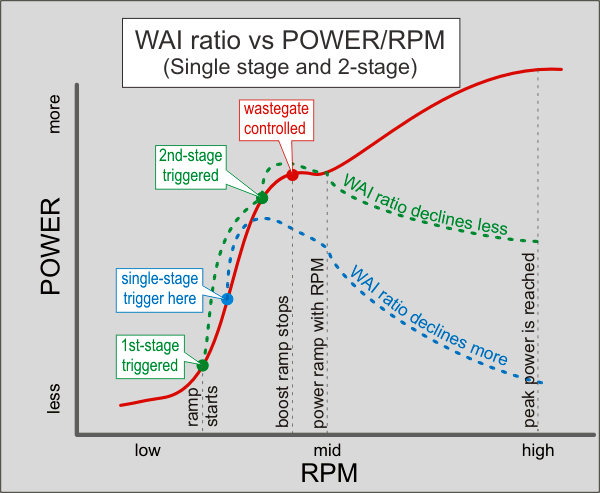
END
--------------------------------------------------------------------------------
--------------------------------------------------------------------------------
Propressive Pump Speed system (PPS)
(2nd September 2007)
(2nd September 2007)
Does the pump speed controller perform better than a two-stage system, you are about to find out.
Changing pump speed merely put more pressure behind a nozzle, hence more flow. This type of system is commonly known as a progressive system (pump-speed).
Let us examine how much a M5 nozzle will flow between 40psi to 160psi. According the chart below (Published by Hago, a well know US oil heater nozzle manufacturer), the flow starts from 200cc/min and ends at 400cc/min., when pressure is increased from 40psi to 160 psi.
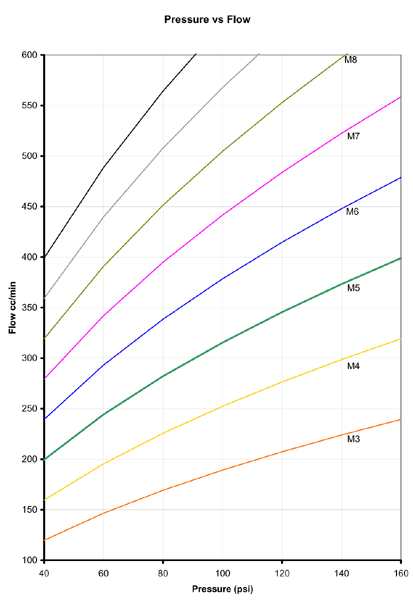
Almost all PWM pump controller on the market uses Shurflo pump, designed to operate between 0-150psi. The heart of the system is an electronic motor speedcontroller, vary the speed according to a sensor. It could be a MAP sensor, a MAF or any sensors that read engine load. It is normally a 2-dimensional system. A manifold-pressure type system does not take into account of any RPM change.
A swirling type atomising nozzle requires a head pressure of at least 30psi to produce a decent mist. Droplet size is very important to the inlet cooling ability and even cylinder distribution. Let say the system pressure starts at 40psi (as shown on the chart) and ends at 160psi. One can assume you will get a 4x flowrange? In practice, not so, according to the chart, you will only get a flow change from 200cc/min to 400cc.min (see M5) instead of 200cc/min to 800cc/min. Flow/pressure obeys the square-root law.
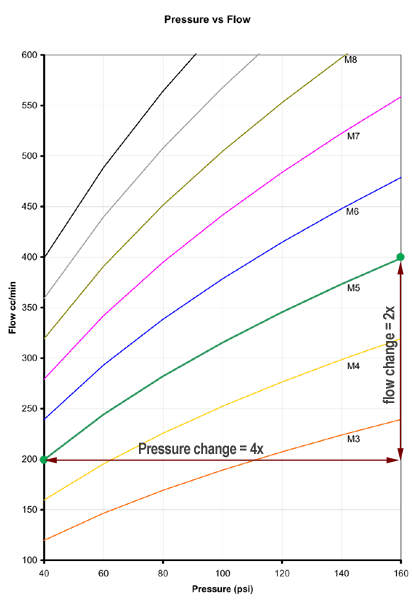
Being "progressive" implies a reasonable dynamic range between start and finish. How progressive? Almost no one ever questions this. Most people just assumes it covers all the flow requirement between 10psi to 20 psi of boost once the range-dials are set on their pump speed controller. In practice, you cannot expect the same M5 nozzle will serve a wider operating range between 5-25psi by merely changing the dial, the range is governed by the law of physics and not a technically advanced motor speed controller.
If one would want to delve deeper into the subject, as the title demands. So the subject will continue?
Just to recap, good dynamic range (pressure/flow span) is the main factor one should expect from a "progressive" WIA system. Let see what a 150psi system can really offer. We shall take into account of the effect of manifold pressure, inline checkvalve as well as minimum pressure for a good atomised spray.
For example:
1) Manifold pressure start: 10psi
2) Manifold pressure ends: 20psi
3) Inline checkvalve crack pressure: 20psi (updated)
4) Minimum pressure of the atomising nozzle:40psi (Hago chart).
When the system starts: it will instantly see an initial back-pressure of 60psi and a final back-pressure of 70psi (extra manifold pressure). The actual dynamic pressure range is now from 60psi to 110psi. The system can now only manage a 35% change in flow, far from one would imagine a 150psi pump system should perform.
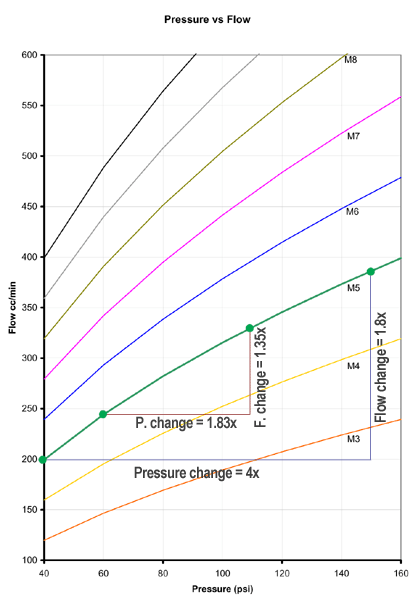
There are other factors that could also affect the performance of the 2-D progressive pump system. It may be a subject for a later discussion, depending on the interest of the readers. Chart below is a predicted performance of a progressive system compared to a single and two-stage system. I hope there will be people chiming in to add to this. At first glance, it doesn't appear there is a distinct advantage for adding a progressive controller. Adding a bigger nozzle doesn't alter the dynamic range, it just shifts the whole curve higher.
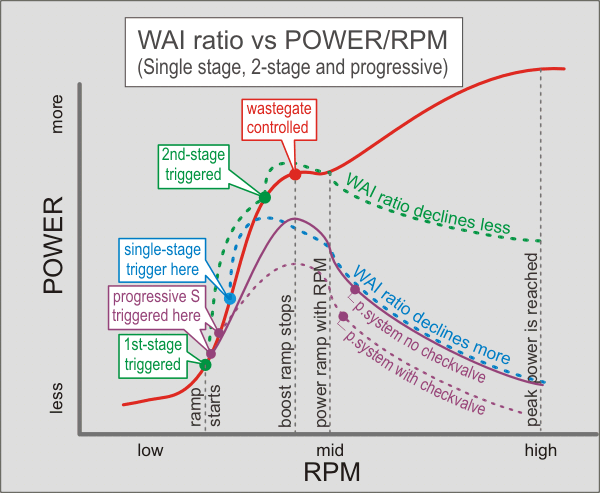
FOR:
1) Easy to set the start and end point.
2) Some correlation between manifold pressure and flow
3) Cost effective.
AGAINST:
1) Limited dynamic range, system becomes less effective after wastegate pressure. (see addendum)
2) Extra cost can easily be spent on a higher performance two-stage system with greater dynamic range .
3) If the 2-D system is used to replace high % fuel with alcohol, re-mapping the 3-D fuel map will be very difficult due to the wide dynamic flow rangedemanded by the engine.
4) Pulsing due to demand switch ~20psi ripple. (some system by-pass this switch, but risking system pressure beyond design limits). May require further explaination
5) Response time due to inertia of a rotating - laggy (start) and over-run (stop). May require further explaination
END
--------------------------------------------------------------------------------------
--------------------------------------------------------------------------------------
PWM valve water injection system:
These systems require a stable system pressure, normally held between 100-125psi. An inline solenoid valve and a PWM controller that modulates the opening and shutting time to meter flow. Before getting too deeply into the subject, note that there are two types of inline solenoid valves on offer.
Type #1
Pulse width modulation type:
(Optimum operating frequency range: 30-80Hz)

This type of system resembles the modern automotive
The valve behaves similar to an on/off gated button on a garden hose. The longer the gate is opened, the more the flow (duration). Alternative, rapid opening/shutting the gate per second (frequency) also control the flow. The common EMS uses duration for load change and frequency for RPM change. The dynamic flow range is extremely wide, 100:1 is normal.
A WAI valve should closely match the closing and shutting characteristic of a fuel
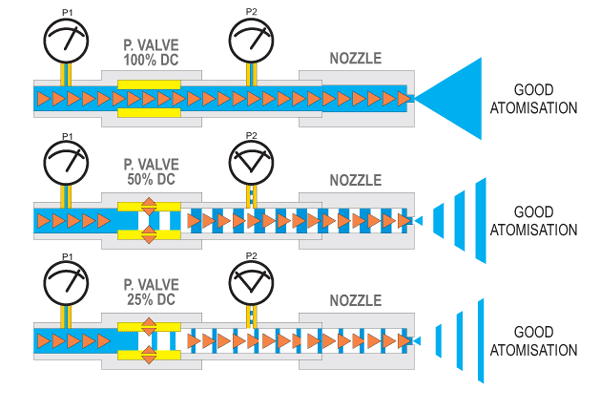
-------------------------------------
Type #2
Proportional lift type:
(Chopped DC (~400Hz) or DC current)

This type of valve resembles the action of a rotary water tap. As more current is applied to the valve coil, the higher the valve lifts from the seat. It is a very nice way to control flow.
There are a few minor problems associated with this type of valve: Atomisation at low flow (see paragraph below) and lift variations (hystersis of the magnetic circuit), approximate +/- 10-15% flow deviations.
All in all, it will deliver liquid well compared to the PPS system. There are some similarities between the two. The nozzle tip pressure is directly proportional to the flow. This is because the proportional valve acts like a variable restrictor upstream of the nozzle tip. Resulting in: restricted flow = low pressure. Low pressure = low atomisation.
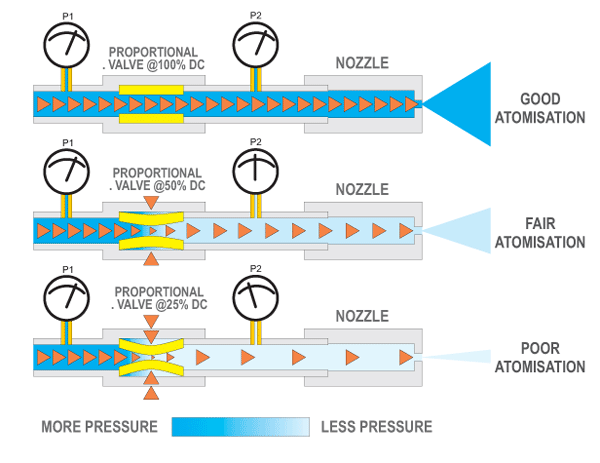
----------------------------------
Summary:
It is important to know some basic facts between the two PWM valve systems before choosing this type of system.
Here is an illustration of the difference in construction of the two valves, made by Clippard. Notice the "PWM" (full "on/off) has a softer spring rate than the "proportional lift" valve, enabling the PWM valve to perform "full on" and "full off" positively.

Because the way the PWM system meters its flow based on a simple pulse width, it is very accurate. Further precision can be increased by introduce a suitable RRFPR to maintain Manifold pressure against manifold pressure. It is also possible to factor in a small duty cycle increase to the valve relative to boost increase.
Final consideration: If you are planning in future to create your own MAP via a third part system - only the "PWM-valve" can be driven directly by the ECU, matching the principle of a modern "fuel injection system" in every respect. Warning, before rushing off making your own system, Clippard valve is only rated up to 100psi, even with the smallest orifice version. The larger orifice type can only sustain 25psi. Multivalve is needed for flows over 500cc/min. Lastly, the valve mentioned has a typical 4mS on and 4mS off time.
END
---------------------------------------------------------------------------
Addendum: Action of a check valve under dynamic conditions:
Almost all progressive systems use a checkvalve between the pump output and nozzle for the reasons listed below:
Positive effects (well documented):
1. Retain some pressure in the line to compensate the next injection event. A 20psi loaded checkvalve will keep 20 psi of pressure in the line after injection.
2. Stop water being siphoned into the engine if the water jet is installed in the vacuum side of the manifold.
3. Prevent emptying the entire tank into the inlet tract if the tank location is higher than the jet (gravity fed) or the car is parked on an incline.
4. Stop some dribble after an injection event. Even when the power of the pump is switch off, the inertia of the rotating mass keeps the pump running for a second or so.
Negative effects (less well documented):
5. The presence of a checkvalve has a very significant impact of the dynamic range of a 150psi progressive pump speed system. A 20 psi checkvalve inline will instantly drop the 150 PPS system down to a 130psi span.
6. A normal nozzle requires ~30psi for produce a decent atomised spray. An inline 20psi checkvalve means the pump has to produce 50psi to produce a decent spray.
7. Let say the PPS system’s starting point is at 12psi boost, the system will now require 62psi to produce a decent spray. Some vendor will tell you a check valve will not impede flow once it is opened, true. But it will tax the pressure heavily where the PPS system relies heavily upon.
8. When the PPS system arrives at 24psi boost (end point) manifold pressure, the dynamic pressure is now further taxed. Before not too long later the dynamic range of a PPS system is now from 62psi to 126psi – translate it to flow: 176cc/min to 326cc/min, a mere 84% percent increase.
9. I have taken some data from a reputable PPS system manufacturer, a 150-psi 60W Shurflo flow pump has the follow characteristics:
Most important thing to remember, nozzle size determines output pressure (updated on the 21st January 2008) .
M1 (not tested)
M2 230psi
M3 225psi
M3 215psi
M5 190psi
M7 180psi
M10 170psi
M12 (not tested) did not have one handy.
M14 155PSI
From the figures above, the pump is only capable of sustaining 135psi system pressure on a M5 nozzle. Despite claiming the pump is capable of flowing one 3-4 litre per minute, conveniently missing the pressure parameter. The above PPS system maker is the only one that published these figures in public – thumbs up for them.
NOTE: The above data is from one maker only (as stated) Please read post #3 to understand why different WAI makes uses differ pumps, some make more flow and pressure than others.
Summary:
Some PPS system makers are now offering an inline solenoid upgrade so that the dynamic range is improved by a good margin. Not sure why they didn’t include it in the kit at the beginning. Many PPS systems run their pumps up to 200-300psi - something I have questioned Shurflo, they said NO, NO and NO - no "ifs" or "buts". They are looking into a higher pressure pump but not yet done and will not be released until they are comfortable with it. I have a meeting with the Shurflo's director of engineering at our works two months ago during his UK visit - he confirmed the imaginary 200psi+ pump (8000 series).
Here is an illustration of the above in graphical form:
![Click here to enlarge]()
Bench test set up of a 8-psi checkvalve
![Click here to enlarge]()
Video is ready to be viewed: Click here
(ONLY works with Microsoft IE)
Download video: Click here
Here are abner's Check valve test - please be patient, video files are about 5MB
NO CHECK VALVE (see video)
Download (1.78MB): Click here
ONE CHECK VALVES (see video)
Download (4.40MB): Click here
TWO CHECK VALVES (see video)
Download (3.86MB): Click here
The final flow quantity should give you some clues on the effect of the CV.
---------------
It appeared Shurflo is the main supplier of the majority of water/alcohol injection systems makers. So it is more appropriate to take a good look into them first. You will be amazed to know how many pump variations Shurflo offers over the standard "off the shelve" configuration. I was told it has over 300+ "custom" configuration is still active.
Pump motor:
Currently, there are three frame sizes: short, medium and long stack, covering three power ratings of 60W. 100W and 150W.
![Click here to enlarge]()
Pump cam angle:
Cam angle dictates and governs the final specifications of pump's flow rate, pressure. Shurflo offers: 2, 2.5, 3.0, 3.5 or possibly more profiles. Depending on the application, WAI makers can select the most suitable cam for their system.
At first glance, using the highest lift cam will produce the most flow and pressure. But if this cam is matched with a small motor, it will cause undue stress on the motor winding. This is very similar to going up a steep incline on high gear where the car's engine and gearbox is being stressed.
On the other hand, a low cam angle will produce less pressure and flow. Some PPS manufacturers prefers using the lower angle cam because of the following (as long as it delivers the specified flow) :
1. Less stress to the diaphragm - long term mechanical reliability
2. Less stress to the motor - lower running temperature.
3. Within a flow range up to 1000cc/min or so, there is ample pressure generated to hold the system at 150psi.
4. A much smoother control range from a PPS controller. High cam lobe tends to ramp up too much pressure with the same duty cycle applied -making the ramp-up abrupt - similar to using 2nd gear to get the car moving.
5. The pressure spike is also much smaller, this allows the peak pressure closer to the "150psi demand switch". Overshooting will cause the infamous "pulsing" often associated with a PPS system.
Note: a system advertised as 150psi@3 litre/min may NOT out-perform a 150psi@1 litre/min system. Often, the latter is a much better system. As far as the raw material cost difference is concerned, there is NONE. In these days, hypes rules the market.
By-Pass pump (no demand switch):
Shurflo Offers a huge range of internal by-pass valve to overcome the necessity of using a "demand switch" . Excess pressure is being "by-passed" internally by a set of spring load poppet valves (x3).
This type of configuration is more suited for PWM valve system rather the PPS system. The pump is switched on just before injection, attains a "steady" line pressure continuously through out the entire delivery cycle.
Only a very small numbers of PWM valve WAI manufacturer uses this set up.
Regulating pump pressure steady (with on-demand switch):
Other than employing the bypass valves, the water pressure can be limited by using an "on-demand" switch. This method is simple, every time the pump hits the "set pressure" of the on-demand switch, the 12V feed to the pump is interrupted. Shurflo recommends this method should only be applied to application where the usage is intermittent and not cyclic use.
Against the recommendation, there are WAI systems on the market employ this technique to control water pressure. Most PPS systems only hit this pressure at peak injection pressure intermittently so long term damage to the pump is not severe. Pressure spikes of 20psi+ exists.
If this method is being used to regulate water pressure on a PWN valve system, it is a completely different story. The "intermiittent" use now becomes " cyclic" usage. This will create long term problem on the switch as well as the pumping mechanism. Water pressure will also suffer from pressure spikes, sometimes as much as 20+psi spike. Using a low hysteresis switch may reduce the ripple but the other half of the problem still remains.
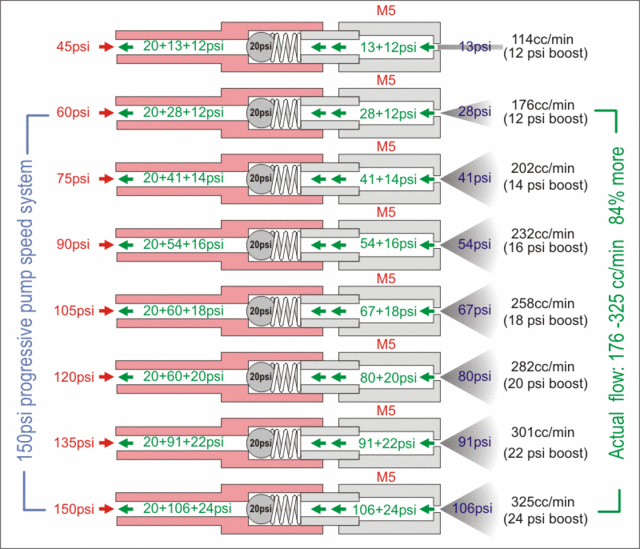
Bench test set up of a 8-psi checkvalve

Video is ready to be viewed: Click here
(ONLY works with Microsoft IE)
Download video: Click here
Here are abner's Check valve test - please be patient, video files are about 5MB
NO CHECK VALVE (see video)
Download (1.78MB): Click here
ONE CHECK VALVES (see video)
Download (4.40MB): Click here
TWO CHECK VALVES (see video)
Download (3.86MB): Click here
The final flow quantity should give you some clues on the effect of the CV.
---------------
Addendum: Knowing the heart of a WAI system: The pump
It appeared Shurflo is the main supplier of the majority of water/alcohol injection systems makers. So it is more appropriate to take a good look into them first. You will be amazed to know how many pump variations Shurflo offers over the standard "off the shelve" configuration. I was told it has over 300+ "custom" configuration is still active.
Pump motor:
Currently, there are three frame sizes: short, medium and long stack, covering three power ratings of 60W. 100W and 150W.
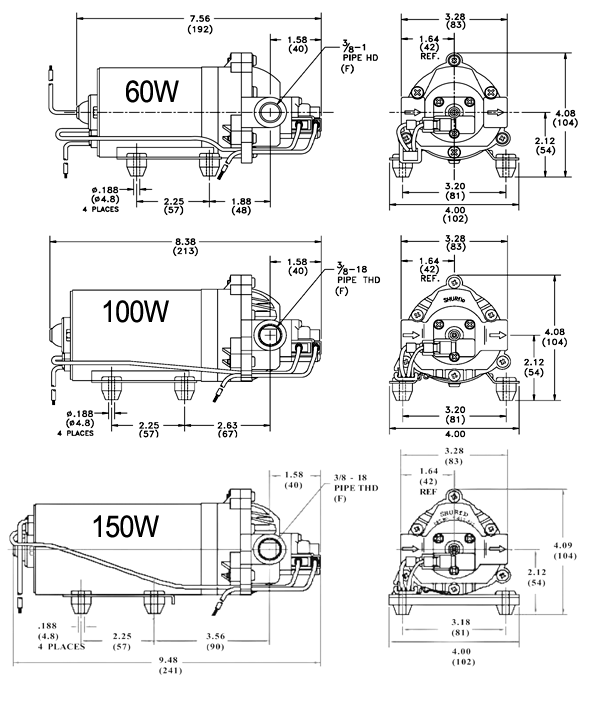
Pump cam angle:
Cam angle dictates and governs the final specifications of pump's flow rate, pressure. Shurflo offers: 2, 2.5, 3.0, 3.5 or possibly more profiles. Depending on the application, WAI makers can select the most suitable cam for their system.
At first glance, using the highest lift cam will produce the most flow and pressure. But if this cam is matched with a small motor, it will cause undue stress on the motor winding. This is very similar to going up a steep incline on high gear where the car's engine and gearbox is being stressed.
On the other hand, a low cam angle will produce less pressure and flow. Some PPS manufacturers prefers using the lower angle cam because of the following (as long as it delivers the specified flow) :
1. Less stress to the diaphragm - long term mechanical reliability
2. Less stress to the motor - lower running temperature.
3. Within a flow range up to 1000cc/min or so, there is ample pressure generated to hold the system at 150psi.
4. A much smoother control range from a PPS controller. High cam lobe tends to ramp up too much pressure with the same duty cycle applied -making the ramp-up abrupt - similar to using 2nd gear to get the car moving.
5. The pressure spike is also much smaller, this allows the peak pressure closer to the "150psi demand switch". Overshooting will cause the infamous "pulsing" often associated with a PPS system.
Note: a system advertised as 150psi@3 litre/min may NOT out-perform a 150psi@1 litre/min system. Often, the latter is a much better system. As far as the raw material cost difference is concerned, there is NONE. In these days, hypes rules the market.
By-Pass pump (no demand switch):
Shurflo Offers a huge range of internal by-pass valve to overcome the necessity of using a "demand switch" . Excess pressure is being "by-passed" internally by a set of spring load poppet valves (x3).
This type of configuration is more suited for PWM valve system rather the PPS system. The pump is switched on just before injection, attains a "steady" line pressure continuously through out the entire delivery cycle.
Only a very small numbers of PWM valve WAI manufacturer uses this set up.
Regulating pump pressure steady (with on-demand switch):
Other than employing the bypass valves, the water pressure can be limited by using an "on-demand" switch. This method is simple, every time the pump hits the "set pressure" of the on-demand switch, the 12V feed to the pump is interrupted. Shurflo recommends this method should only be applied to application where the usage is intermittent and not cyclic use.
Against the recommendation, there are WAI systems on the market employ this technique to control water pressure. Most PPS systems only hit this pressure at peak injection pressure intermittently so long term damage to the pump is not severe. Pressure spikes of 20psi+ exists.
If this method is being used to regulate water pressure on a PWN valve system, it is a completely different story. The "intermiittent" use now becomes " cyclic" usage. This will create long term problem on the switch as well as the pumping mechanism. Water pressure will also suffer from pressure spikes, sometimes as much as 20+psi spike. Using a low hysteresis switch may reduce the ripple but the other half of the problem still remains.